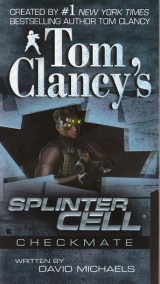
Текст книги "Checkmate (2006)"
Автор книги: David Michaels
Жанр:
Боевики
сообщить о нарушении
Текущая страница: 14 (всего у книги 21 страниц)
40
WITHa gentle kick of his fins, Fisher eased forward until he felt his belly scrape the soft sand of the beach. He felt a wave wash over his back and his vision was momentarily obscured by froth. As the wave receded, he lifted his head until his face mask broke the surface. Ahead, he could see the line of white beach that followed the base of the cliff, itself a vertical wall of mottled gray rock.
He’d timed his approach to coincide with high tide for two reasons: One, the breakers would be easier to manage, allowing him to crawl into the shoals while remaining partially awash. And two, the higher the tide, the less beach he would have to cross to reach the base of the cliff, decreasing his chance of being spotted.
True to to his reputation, Collins had expertly guided the Houstonnorthward into the heart of the East China Sea, past the Chinese 093s, and finally to the mouth of Hangzhou Bay and the Zhoushan Archipelago. For a standard special ops insertion, the Houston’s forward deck would have been fitted with a clamshell dry dock shelter and an SDV, or Swimmer Delivery Vehicle, but the accelerated nature of Fisher’s mission had made this impossible, so he’d simply exited the sub’s forward escape trunk and swum the half mile to the island.
So far the weather was partially cooperating with his plan. The sky was clear, with an occasional scud of clouds passing before the moon. According to Collins’s weather officer, a tropical storm was working its way up from the South China Sea, pushing a line of rain squalls before it.
Fisher reached back and plucked his binoculars off his harness. He scanned the top of the cliff, looking for movement or headlights. He saw nothing. He replaced the binoculars and moved his left arm forward until his could see the OPSAT’s screen. He punched a button and a map of Cezi Maji appeared in the green glow.
Grimsdottir had done her usual thorough job, having divided the map into three views: standard topographical with geographical features, EM, and infrared, each of which was labeled according to Smith’s brief: cliff road; outer rain forest; inner cutback zone; and the estate proper. A variety of multicolored symbols marked known locations of cameras, sensors, sentry zones, and fences.
Looking at the fortress that was Bai Kang Shek’s island, Fisher felt a momentary tingle of apprehension, but he shook it off. Break it down, Sam,he commanded himself. One step at a time. One camera, one sensor, one sentry.
He lowered his face mask back into the water and started inching forward.
TENminutes later, he was across the beach and hidden amid the rocks at the base of the cliff. Behind him, waves hissed over the sand and retreated, leaving a cream of froth. He picked his way along the cliff until he had a clear view of the top, then waited.
His wait was short. Eight minutes later, he saw a pair of headlights moving through the foliage. They stopped and went dark. A few seconds later, a flashlight blinked on. In the moonlight Fisher could see a figure standing at the edge of the cliff. The guard played the flashlight over the rock face, then down and over the sand.
The flashlight blinked out. The headlights glowed to life and started moving away.
Fisher tapped the button of the OPSAT’s screen labeled LOCKand the red diamond symbol on the cliff road started flashing. LOCK ENABLED. With the jeep patrols on a predictable schedule, all Fisher had to do was lock in the appearance of one them to track the rest. One by one, the remaining five jeep patrols popped onto the screen at various points along the cliff road.
A set of scrolling numbers next to each diamond showed the time remaining until it reached Fisher’s position. He had six minutes until the next. He punched up the OPSAT’s comm screen and tapped out a message– FEET DRY—and hit send. Given the inordinately high level of the island’s security, he and Lambert had agreed to forgo normal check-in procedures and keep transmissions to a minimum.
He trotted back to the spot he’d chosen earlier and started climbing.
THEcliff was at once a climber’s dream and nightmare, a mix of granite, with plenty of lateral cleaves that made for good handholds, and volcanic basalt that was in some places worn smooth by millennia of weather, but in others, jagged, frangible, and as abrasive as steel wool.
By switching between NV and standard view, he was able to slowly pick his way upward, zigzagging from one granite run to the other until he was halfway to the top. His OPSAT vibrated once on his wrist, then again. He locked his right hand into a crevice and lifted the OPSAT to his face.
On the screen one of the red diamonds was moving down the cliff road, nearing his postion. The time display wound down past sixty seconds . . . fifty-five. . . .
Hand over hand, he moved left, toward a nose-shaped hump in the cliff. When his shoulder bumped against it, he lowered himself until he could duck under the tip of the nose. He shoved his hand into a crack until his knuckles were jammed against the stone, then released his left hand and let it dangle.
Above him, he heard the growl of an engine. Brakes squealed. A car door slammed. Then footfalls on gravel and the rustle of foliage. A flashlight beam skimmed horizontally along the cliff face toward him, then up and over the nose and out of sight. Fisher glanced down in time to see the beam track along the beach for a few seconds, then blink out.
He waited until the jeep’s engines had faded, then glanced at the OPSAT. The next jeep was on the east side of the island, a red diamond slowly marching toward him. Seven minutes.
He kept climbing.
WITHtwo minutes to spare, he reached the foliage overhanging the edge. He groped around until his hand found a root and he pulled himself up. He snaked through the underbrush until he reached the edge of the road. A quick EM/NV check up and down the road revealed nothing. He checked the OPSAT: one minute.
The previous day’s rain had left the road muddy—a perfect mold for footprints, so Fisher sidestepped along the grass verge until he found a spot where a pair of flat stones were half-buried in the dirt. He was leaping to first stone when he heard the grumbling of the jeep’s engine. He hopped to the next stone, then to the edge, where he ducked down, slipped into the undergrowth, and dropped flat.
The jeep’s headlights washed over the road. Half a foot away, a mud-encrusted tire rolled past Fisher’s face. The jeep ground to a halt and a car door opened. A voice called something in Mandarin. The reply came from slightly farther away—the first voice from the passenger; the second from the guard who’d gotten out to scan the cliff face.
Half a minute later, the jeep was moving again.
Fisher maneuvered his arm up until he could see the OPSAT. He punched up the map. The outer ring of rain forest lay before him. Three miles of unbroken jungle, two escarpments, three gorges.
He had six hours before dawn.
41
FISHERcame to a small stream gurgling its way through the undergrowth, and paused for a break.
On paper, three miles in six hours sounded like an easy stroll. He’d lived and fought and killed in jungles, sometimes for months at a time, and he knew there was nothing easy about it, especially at night. His every step, his every breath, his every hand placement was fraught with hazard.
His NV was virtually useless. With only the occasional game trail to follow, he had to force his way steadily through foliage so thick, all he saw in his trident goggles was a wall of leaves and branches that parted with his passing only to immediately close behind him. Every step involved either ducking or twisting or crab-walking around an obstacle. The canopy above blotted out all but fleeting glimpses of sky and moonlight. As it was, the ambient light was barely enough to feed the NV.
The heat, which hovered at ninety degrees, was coupled with ninety-percent humidty. In his peripheral vision, he could see bits of movement as the jungle’s night creatures scurried away. Serrated vines and spiked leaves crisscrossed his path, scraping his exposed skin raw. Flying insects, some so small they were invisible, others as big around as a quarter, swirled around his ears and eyes and nose.
And while every facet of breaking a jungle trail was exhausting, Fisher knew the physical stresses were only the tip of the iceberg. No other environment on earth worked on the human psyche the way a jungle could. Facing a curtain of foliage left you with no points of reference. Everything you saw was homogenized. Where you were ten feet ago looked eerily similar to where you were now. Without a tight rein on your mind, hopelessness starts to creep in, followed by panic and mental paralysis.
For all its danger, though, Fisher loved the jungle. It was the great equalizer. Every hazard you face, your enemy faces; the same wall of foliage that hides him, hides you. The difference between killing your enemy or dying at his hands becomes a matter of patience and stamina and focus.
HEsat on the bank of the stream with his back against a trunk. He dipped his bandanna into the water. It was surprisingly cold. He wiped his face and neck; the coolness was invigorating. He pulled his canteen off his belt and drank it all down. The jungle sucks moisture from the body at an incredible rate—every breath and every drop of sweat is a step closer to heat stroke.
He laid the canteen on its side in the stream until it was full, then dropped in two chlorine dioxide tablets and recapped it. More often than not, jungle water carried enough bacteria, viruses, and cysts to either kill you or leave you hospitalized for months wishing you were dead.
All around him, the forest floor rustled with life, mostly of the insect variety, from ants to spiders to beetles. Something shook in the canopy, a monkey awakened by his passage. He felt something brush over the tops of his thighs. Moving very slow, he flipped his goggles into place and looked down. A line of leaf-cutter ants, each carrying a half-dollar-sized chunk of leaf, was marching across his legs.
He checked his OPSAT. He’d been going for an hour and had covered half a mile. He checked his coordinates to ensure he was on track, then stood up, stepped across the stream, and kept going.
THEhours passed steadily but slowly as he picked his way inland. At three A.M., he found a game trail barely ten inches wide and followed it as it meandered north. After an hour the trail started to descend. Fisher felt a change in the air, a drop in temperature that could mean only one thing: water.
He heard it before he saw it, a muffled roar somewhere to his left and front. The trail became rockier, the stones slick underfoot. It veered right and kept descending, and soon the roar changed into the unmistakable rush of water. The trail continued to descend for another two hundred yards before the trees thinned out and he found himself standing on a small granite shelf. Across from him was another shelf separated by a ten-foot-wide chasm. He walked to the edge and looked down.
The chasm was twenty feet deep. At the bottom, a river boiled through the confines of the granite walls. To his left, the chasm climbed steadily upward until it reached a small waterfall.
Fisher doubted be could get enough of a running start to jump the gorge, and he knew missing would kill him. The force of the river would grind him into hamburger against the rocks. Nor could he try farther up the trail; the jungle grew right to the edge of the chasm, making a leap impossible. Down, then.
He followed the trail another quarter mile until the terrain leveled out and the chasm widened to thirty feet. Here the water was slower, shallower, and dotted with boulders, but Fisher knew better than to underestimate the river. These were Class V rapids. Even at calf depth, the force of the water would be enough to knock him down.
He studied the boulders. The were wide enough for him and were separated only by a few feet, but they were also slick with algae. He checked his watch. He was behind schedule, and he had no idea what he’d find downstream. This was the place, then.
He took a minute to plan his route, then walked to the edge, coiled his legs, and leapt. It was a frog-hop that landed him splayed, belly-first, across the rock. His tac-suit’s reinforced Kevlar and RhinoPlate took most of the shock, but still, the impact knocked the wind out of him. He recovered, wiggled himself atop the rock, then hopped to the next one. He repeated the process five more times until he reached the opposite shore.
He found a cleft in the granite wall with natural built-in steps; the mud between the stones was indented with animal tracks. A game trail. He climbed up. At the top of the cleft he found another game trail.
BYfive A.M., an hour before dawn, Fisher had closed to within a hundred yards of the cutback section of forest surrounding Shek’s estate. He studied the tree line with his binoculars. Shek’s people had done a decent job of keeping the jungle at bay, having cut back the undergrowth in a nearly perfect curve, leaving only clumps of knee-high grass and small trees.
This was where things would get interesting. There was a full mile of this cutback zone between him and the compound. This was where the roving guards, sensors, and cameras began.
He started looking for a bolt hole in which he could spend the day. He found it half mile to the west: a dead tree that had fallen across some small boulders. He scooped out a hollow beneath the tree, then built a blind made of nearby foliage that he carefully uprooted, then replanted. Wilted leaves would be a telltale sign that no good security patrol would miss.
Once satisfied with the shelter, he crawled inside and pulled the foliage closed behind him. Piece by piece, he removed his harness and gear and laid everything within arm’s reach. One more task before he could sleep.
He tapped out a message on his OPSAT:
IN PLACE, WAYPOINT ONE. ALL IS WELL. WHAT’S LATEST?
The message came back twenty seconds later.
IRANIAN KILO-CLASS SUBMARINE ATTEMPTED PENETRATION REAGAN BATTLE GROUP PERMI-ETER, GULF OF OMAN. SUBMARINE DRIVEN OFF, RAN AGROUND NEAR JASK PENINSULA. EMERGENCY SESSION OF UN SECURITY COUNCIL IN PROGRESS.
Escalation,Fisher thought.
42
THEday passed at a crawl as Fisher lay still inside his blind, alternately dozing and studying Shek’s estate, which had with the light of day become partially visible through the trees. Over the roofs of the outbuildings he could see the pagoda’s red-tiled roof, and here and there he caught glimpses of guards and grounds workers moving about. He saw only Chinese faces.
He was at roughly the nine o’ clock position of the imaginary clock face that divided the cutback area. Each of the twelve zones was an acre, Fisher estimated. Since shortly after dawn, when an armed guard had passed within thirty feet of his blind, he’d seen no one outside the fence, which meant patrols were suspended during daylight hours.
According to his OPSAT map, there were four camouflaged cameras hidden in the trees along his front. On the screen, their ROD, or Range of Detection, was displayed as a rotating cone. Getting past them during the day would be impossible; The coverage was too complete, the timing too dicey.
At noon, with the heat and humidity at 90/90, three groundskeepers in a white tunics and straw hats exited the gate and strolled around the cutback zone for two hours, hacking at foliage with scythes and machetes, before returning to the compound.
Fisher spent the remainder of the afternoon lying as still as possible, conserving water and energy as he timed patrols, looked for blind spots, annotated his map, and waited for nightfall.
He thought about Bai Kang Shek.
The man’s link to the Trego,and thereby the Slipstone attacks, seemed irrefutable, but neither did it make sense. Why would an eccentric billionaire recluse who’d retreated to his own private island fifteen years earlier orchestrate a radiological attack on the U.S.? Certainly, he had the money to pull it off, but what was the motivation? And why implicate Iran? What was to gain?
SHORTLYbefore dusk, Fisher watched through his binoculars as the compound’s night shift came on duty. Singly and in pairs, guards began assembling near the main gate until he counted a dozen. Each man carried a Heckler & Koch MP-5 compact assault rifle. A supervisor called them together and gave them what Fisher took to be instructions and/or a pep talk. Weapons were checked, radios tested, and then the gate swung open and the guards filed out.
Time to go to work,Fisher thought. He donned his harness, replaced all his gear into his pouches and pockets, then checked his pistol and SC-20. He then buried the wrappers from his rations in pre-dug holes and filled them in.
Once through the gate, the guards parted company, each man heading toward his zone on the clock face. Fisher’s guard, whom he named Stumpy because of his short legs and barrel chest, arrived five minutes later and began patrolling. He moved through the zone steadily, with purpose and precision, placing his feet flat on the ground, testing his weight before moving the next foot, eyes always moving, MP-5 held ready. This answered one of Fisher’s lingering questions: the source of Shek’s security force. If this guard was typical, Fisher was dealing with ex-soldiers, possibly special forces types. They weren’t likely to make big mistakes or overlook small details.
Night fell quickly, fading from twilight to complete blackness in twenty minutes. Just as quickly, the trees around him went from the subtle insect drone of a daylight jungle, to a symphony of squawks and buzzes and croaks as the nocturnals came alive.
With the darkness came the urge to move, to get on with the job, but Fisher reined it in. He had eight hours of night ahead of him and he was prepared to use every minute of it, if necessary. Using infrared and NV, he kept track of Stumpy as he meandered around the zone, After forty minutes, Fisher’s patience paid off. He began to notice a redundancy to Stumpy’s route: a Z-shaped pattern, followed by an N-shaped pattern, and so on.
Having already timed the camera’s movements, Fisher waited for his moment, then slipped out of the blind and ran, hunched over, to a patch of underbrush in a camera’s blind spot. Stumpy was to his left, moving along the perimeter. Fisher checked the OPSAT. The cameras, one to his left and one to his right, were rotating past him, their ROD cones brushing against his hiding spot, but not quite touching him.
He got up, sprinted forward twenty feet, ducked behind a tree, and checked Stumpy’s position. He was now thirty feet away, at Fisher’s ten o’ clock. Wait,he commanded himself. Wait. . . The next move was the trickiest. Once through the cutback, he had fifty feet of lawn to deal with before reaching the fence. Separating the cutback zone and the lawn was a line of groomed hibiscus hedges. Trimmed into a boxcar shape, they were lovely to look at, but a security mistake he was only too happy to take advantage of.
He waited until Stumpy passed by and disappeared through the trees, then shimmied forward just in time to miss an intersection of two camera cones, then stood up and sprinted the remaining eighty feet to the hedges, where he dropped on his belly, found an opening in the branches, and crawled through to the grass verge. He spread himself flat and went still.
The grass blades were topped in a layer of condensation and the moisture felt cool on his skin. From the corner of his eye, he watched an errant nightbee land on a hibiscus bloom, gather some butter-yellow pollen on his legs, then buzz away. Beyond the hurricane fence, he could see the rear wall of one of the outbuildings. Along its eaves, spaced every ten feet or so, were floodlights. They were dark, which suggested they were motion-sensored. Mounted atop each fence post was a rotating camera. All but one of them—the middle one—faced outward. He switched his goggles to EM.
In the pulsing blue field, each camera was surrounded by a swirling halo—its own unique electromagnetic signature. Just as a radiologist learns to decipher seemingly obscure X-rays, Fisher had over time learned to read EM patterns. He could tell these cameras were night-vision-equipped.
This was going to be dicey. His timing would have to be perfect.
He watched and waited.
FOURminutes later, a roving guard appeared around the corner of the outbuilding. He stopped, flipped open a small recessed panel, and punched a code into a keypad. This was the first Fisher had seen of a panel, but he immediately understood its purpose.
The guard shut the cover and strolled along the fence, moving right to left. None of the motion floodlights came on. Halfway along the fence, the guard stopped before the inward-facing camera for a count of three, then walked on and disappeared around the opposite corner of the building.
Watching the process told Fisher much: The guard’s failure to stop at a second control panel meant the alarm override for the floodlights was on a delay; the inward-facing camera was a checkpoint; and the guard’s lack of NV goggles meant his stroll along the fence was to check for breaches. The lawn, the hedges, and the edge of the cutback weren’t his zone of responsibility.
The motion lights were the easiest to disable. Fisher pulled the SC-20 from his back holster, settled it into the crook of his arm, and took aim. He fingered the ZOOMtoggle once, then twice, centering the reticle on the light. He fired. With a tinkle of glass, the light shattered. He adjusted aim, fired again, and killed the next light. He reholstered the SC-20.
Next he pulled a scopelike object from his belt, attached it to the pistol, and flipped on the power switch. With a faint hum, the camera jammer powered up. Despite the jammer’s obvious benefits, Fisher tried to avoid using it for two reasons: One, it consumed a lot of power, and he wasn’t fond of carrying any more battery weight than necessary. And two, using it required precise and unwavering aim. One tremble of the hand or misstep of the foot and you risked dropping the interference. He checked his OPSAT, watching the fence cameras go through their rotation, watching their cones overlap and separate . . . overlap and separate. . . .
From behind the hedge came a twig snap as Stumpy passed by.
Overlap and separate . . . overlap and separate . . .
Now.
He rose into a crouch, took aim on the camera nearest him, pulled the jammer’s trigger, and started walking forward. He kept his pace steady, his aim level. The camera made a rapid tick-tick-ticksound as the jammer scrambled the circuits.
When he was three feet from the camera, he released the jammer’s trigger and flattened himself against the fence. Safe. For now. Surveillance cameras didn’t cover close-in, horizontal surfaces very well; the mechanics of their motion usually left a blind spot along a wall or fence.
He waited for the cameras to complete a rotation, then mounted the fence and climbed to the top, where he flipped onto his back and shimmied over the razor wire until he was lying spread-eagle, back arched. He said a silent thank-you to Kevlar and RhinoPlate: handy against bullets and razor wire alike.
In one fluid motion, he pushed off with his feet and swung his arms up and over. The sudden momentum, combined with the spring of the wire, vaulted him backward. He did a full reverse somersault and landed on the grass in a crouch, then stepped to the fence and froze beneath the inward-facing camera. He waited until it panned away, then sprinted to the building, around the corner, and down the wall to the next corner, where he stopped and peeked around.
He was at the edge of a short dirt road. To his left, fifty feet away, was more hurricane fence; to his right, an open-fronted twelve-stall garage; the first six stalls were empty, the last six filled with jeeps like the ones he’d encountered on the beach road.
He felt the OPSAT vibrate on his wrist. He checked the screen:
INCOMING VOICE TRANSMISSION . . . RECEIVE ON ENCRYPED BUTTON FOUR.
Button Four was reserved for heavily scrambled and encrypted voice comms. What could be important enough to break radio silence? He keyed his subdermal. “Up on secure button four.”








